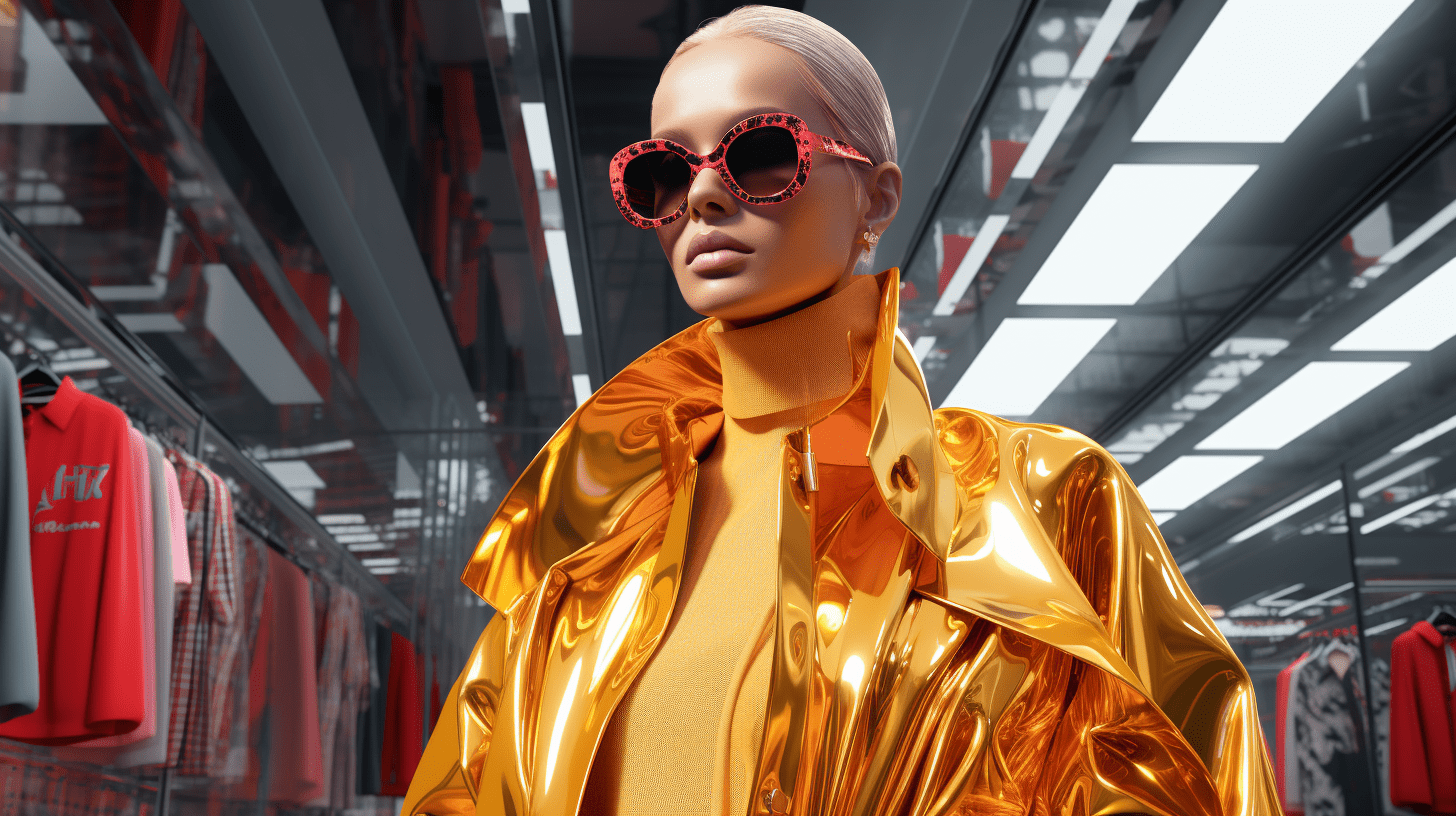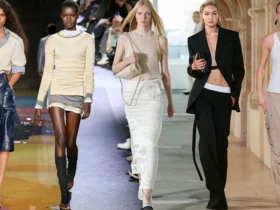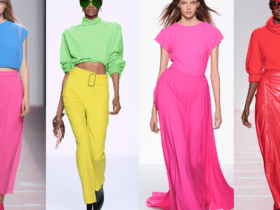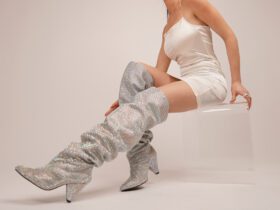In the ever-evolving landscape of fashion, the term “Metaverse” has emerged as more than just a buzzword—it’s a seismic shift that’s redefining the industry. The Metaverse, a collective virtual shared space, is accessible via virtual and augmented reality technologies. It’s not merely a new platform for fashion; it’s a paradigm shift that’s redefining what fashion can be.
The Metaverse is a confluence of technology and imagination, a digital realm where the boundaries between the real and the virtual blur. It’s a space where designers can push the envelope, transcending the limitations of physical materials and production processes. It’s also a realm where consumers can experience fashion in a more interactive and personalized way, from virtual try-ons to digital fashion shows.
According to a report by Goldman Sachs, the virtual reality (VR) market is expected to reach $80 billion by 2025, with fashion being one of the key sectors to benefit from this growth. This is not surprising, given that fashion has always been a form of self-expression, and the Metaverse provides a new, limitless canvas for this expression.

The Genesis of Virtual Couture
Before the term “Metaverse” entered our lexicon, the fashion industry was already exploring the digital realm. Computer-aided design (CAD) tools have been a staple in fashion design for years, helping designers bring their visions to life with greater accuracy and efficiency. However, the Metaverse takes this digital craftsmanship to an entirely new level, transforming static designs into interactive, 3D experiences that can be worn, shared, and even sold in virtual worlds.
The shift from CAD to the Metaverse is akin to the transition from black-and-white television to color—it’s the same medium, but the experience is profoundly different. In the Metaverse, garments are not just visual elements; they are interactive assets. They can respond to the user’s movements, adapt to different virtual environments, and even change their appearance based on specific triggers, such as time of day or weather conditions in the virtual world.
This level of interactivity opens up new avenues for creativity and innovation. For instance, designers can now create garments that change color or pattern in response to the user’s emotions, detected via biometric sensors. This is not science fiction; it’s a reality made possible by the convergence of fashion and technology.
According to a 2021 report by Business of Fashion, investments in fashion technology have surged by 60% in the past two years. A significant portion of this investment is directed towards virtual reality and augmented reality applications, signaling the industry’s recognition of the Metaverse’s potential.

The Virtual Runway
Fashion weeks have long been the epitome of glamour, exclusivity, and artistic expression. However, the COVID-19 pandemic forced the industry to rethink its approach to these grand events. Enter the Metaverse, where brands like Balenciaga and Gucci have ventured, hosting virtual fashion shows that are as intricate, captivating, and star-studded as their physical counterparts.
These virtual runways are not just a temporary fix to pandemic-induced restrictions; they are a glimpse into a more inclusive and global future for fashion. In a traditional fashion show, the audience is limited to industry insiders, celebrities, and a few lucky fans. In contrast, a virtual runway can be accessed by anyone, anywhere, democratizing the experience and expanding the consumer base.
The technology behind these virtual runways is nothing short of revolutionary. Utilizing real-time 3D graphics, spatial audio, and even haptic feedback, these shows create an immersive experience that rivals, and sometimes surpasses their physical counterparts. Imagine feeling the texture of a garment or hearing the rustle of fabric as a model walks down the runway—all from the comfort of your home.
According to a 2022 study by Vogue Business, virtual fashion shows have the potential to reach a 40% larger audience than traditional shows. This is not just beneficial for consumers; it’s a boon for designers and brands looking to expand their reach and tap into new markets.

The Democratization of Fashion
The Metaverse is breaking down the barriers of exclusivity in fashion, making haute couture accessible to anyone with an internet connection. This democratization is not just expanding the consumer base; it’s also opening up new avenues for designers who may not have had the platform to showcase their work in traditional settings.
In the Metaverse, the concept of “ownership” takes on a new meaning. Unlike physical garments, which are produced in limited quantities and sold at high prices, digital couture can be replicated infinitely and sold at a fraction of the cost. This opens up haute couture to a broader audience, making it more accessible and inclusive.
Moreover, the Metaverse allows for a more personalized shopping experience. Consumers can customize garments, trying on different colors, patterns, and styles in virtual fitting rooms. They can even see how these garments would look in different virtual settings, from a beachside sunset to a bustling cityscape, enhancing the shopping experience and increasing engagement.
According to a report by McKinsey & Company, the personalization of fashion could lead to a 15% increase in sales. In the Metaverse, where personalization is not just possible but expected, this could translate into significant revenue growth for brands willing to embrace this new digital frontier.

Sustainability and Virtual Fashion
The fashion industry is one of the largest polluters globally, contributing to climate change, waste, and overconsumption. However, the Metaverse offers a groundbreaking alternative: a sustainable approach to fashion that could revolutionize the industry. Digital garments require no physical materials, transportation, or waste, significantly reducing their environmental impact.
Brands like Stella McCartney and H&M are already exploring this avenue, creating digital collections that are as stylish as they are sustainable. These digital garments are not just static images; they are interactive, 3D designs that can be worn in virtual worlds, offering a new form of sustainable fashion that is both engaging and environmentally friendly.
According to a 2022 report by the Ellen MacArthur Foundation, digital fashion could reduce the industry’s emissions by up to 30%. This is a significant figure, considering that the fashion industry is responsible for approximately 10% of global carbon emissions.

The Future: NFTs and Ownership
The concept of ownership is undergoing a radical transformation in the Metaverse, thanks to the advent of Non-Fungible Tokens (NFTs). These blockchain-based digital assets confirm the uniqueness and ownership of digital couture, making them collectible items. This not only adds a layer of authenticity but also opens up new revenue streams for designers and artists.
NFTs are revolutionizing the way we think about fashion and ownership. In the physical world, a garment’s value is often tied to its material, craftsmanship, and brand. In the Metaverse, the value is in the digital code, verified by blockchain technology. This creates a new form of scarcity and exclusivity, as each NFT-backed garment is one-of-a-kind.
According to a report by CoinMarketCap, the NFT market reached a staggering $22 billion in 2022, with fashion NFTs accounting for a significant portion of this market. This shows the enormous potential for revenue and growth in this new digital frontier.
The Metaverse is not a fleeting trend but a seismic shift that is redefining the fashion landscape. As we navigate this digital revolution, the lines between the physical and virtual are blurring, creating a new paradigm where fashion is more interactive, inclusive, and sustainable than ever before.
The implications of this shift are profound, affecting not just how we create and consume fashion, but how we think about concepts like ownership, value, and sustainability. As we stand on the cusp of this digital transformation, one thing is clear: the fusion of virtual reality and couture is not just transforming fashion; it’s redefining it.
As we look to the future, it’s essential to consider the ethical and environmental implications of this new digital frontier. The Metaverse offers unprecedented opportunities for innovation and growth, but it also raises important questions about data privacy, the digital divide, and environmental impact.

















